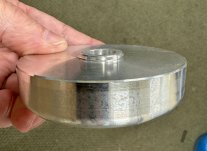I'm not a lathe guy at all. How far out unsupported can I run a 3" bar of 6061 cutting simple features? The part is 3" OD x 0.75" thick, with a .075" boss on the back with the front having a radiused OD edge with a chamfered center hole. Simple less than an inch thick part.
Asking as I run 700 of these parts at a time. The vendor that's been cutting them just upped the price, and it's time I just put a lathe on the shop floor and run them in-house and bring the rest of my round work in-house as it should be. There is not a lot of open space on the shop floor, so a smaller well, used machine for now. So not bar feeding 3"!
Could I hold a 3" 6061 bar, 2" deep in jaws, then have, say, 6" unsupported, and then cut six parts per load? Cut face features, pre-chamfer (groove) the back, drill/chamfer, then groove/part off cut in to create the boss on the back, step over, and part off? Then do this down the material? Maybe lighter cuts/lower RPM at first, then more aggressive closer to the chuck? Just trying not to have to hand load 700 blanks, let alone cut 700 on the saw each run.
This is the back of the part. The front has a large radius, which you can see, and then a countersunk chamfer on the center hole. Simple part.

Asking as I run 700 of these parts at a time. The vendor that's been cutting them just upped the price, and it's time I just put a lathe on the shop floor and run them in-house and bring the rest of my round work in-house as it should be. There is not a lot of open space on the shop floor, so a smaller well, used machine for now. So not bar feeding 3"!
Could I hold a 3" 6061 bar, 2" deep in jaws, then have, say, 6" unsupported, and then cut six parts per load? Cut face features, pre-chamfer (groove) the back, drill/chamfer, then groove/part off cut in to create the boss on the back, step over, and part off? Then do this down the material? Maybe lighter cuts/lower RPM at first, then more aggressive closer to the chuck? Just trying not to have to hand load 700 blanks, let alone cut 700 on the saw each run.
This is the back of the part. The front has a large radius, which you can see, and then a countersunk chamfer on the center hole. Simple part.



